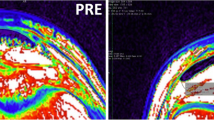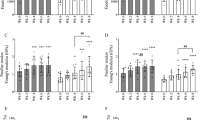Abstract
Human tendon mechanical properties are modified with loading. Moreover, there are indications that the training response in the tendon is gender specific. The aim of the current study was to examine whether in vivo patella tendon stiffness (K) differentially alters with training in older males compared with females. We also aimed to identify which endocrine pathway underlies the responses. Maximal knee extensor forces were also monitored to determine the training effect on muscle function. Fourteen healthy, habitually active older persons (seven males aged 74.0 ± 1.2 years (mean±SEM) and seven females aged 76.7 ± 1.2 years) were tested at baseline and after 12 weeks of weekly, progressive resistance training. With training, percentage increase in quadriceps maximum voluntary isometric force (MVC) was similar in males (2,469.6 ± 168.0 to 3,097.3 ± 261.9 N; +25.3 ± 6.1% (p < 0.01)) and females (1,728.8 ± 136.3 to 2,166.5 ± 135.8 N; +30.4 ± 15.1% (p < 0.05)), respectively. K increased more in males (338.0 ± 26.6 to 616.9 ± 58.7 N/mm; 79.8 ± 4.2% (p < 0.001)) compared to females (338.9 ± 31.0 to 373.2 ± 25.8 N/mm; +13.0 ± 3.7% (p < 0.001)). Interestingly, a pattern was found whereby below ~40% MVC, the females showed their greatest degree of K changes, whereas the males showed their greatest degree of K change above this relative force level. This gender contrast was also true at a standardised force level (1,200 N), with 5.8 ± 0.4% vs. 82.5 ± 1.8% increments in the females (i.e. value change from 380.3 ± 14.1 to 402.4 ± 13.3 N/mm) and the males (i.e. value change from 317.8 ± 13.8 to 580.2 ± 30.9 N/mm), respectively (p < 0.001). While circulating levels of both IGF-I and IL-6 did not alter with training, IGFBP-3 showed a significant training effect (19.1 ± 4.8%, p < 0.001) and only in the male sub-group (p = 0.038). We show here that with training, in vivo older females’ tendon is less dramatically modulated than that of males’. We also show that the relative forces, at which the greatest adaptations are exhibited, differ by gender, with a suggestion of endocrine adaptations in males only. We thus propose that both training and rehabilitation regimens should consider gender-specific tendon responsiveness, at least in older persons.


Similar content being viewed by others
References
Abrahamsson SO (1997) Similar effects of recombinant human insulin-like growth factor-I and II on cellular activities in flexor tendons of young rabbits: experimental studies in vitro. J Orthop Res 15:256–262
Abrahamsson SO, Lohmander S (1996) Differential effects of insulin- like growth factor-1 on matrix and DNA synthesis in various regions and types of rabbit tendons. J Orthop Res 14:370–376
Arampatzis A, Karamanidis K, Morey-Klapsing G, De Monte G, Stafilidis S (2007) Mechanical properties of the triceps surae tendon and aponeurosis in relation to intensity of sport activity. J Biomech 40:1946–1952
Baltzopoulos V (1995) A videofluoroscopy method for optical distortion correction and measurement of knee-joint kinematics. Clin Biomech (Bristol, Avon) 10:85–92
Barone R, Bellafiore M, Leonardi V, Zummo G (2009) Structural analysis of rat patellar tendon in response to resistance and endurance training. Scand J Med Sci Sports 19:782–789
Birch HL, McLaughlin L, Smith RK, Goodship AE (1999) Treadmill exercise-induced tendon hypertrophy: assessment of tendons with different mechanical functions. Equine Vet J 30:222–226
Burgess KE, Connick MJ, Graham-Smith P, Pearson SJ (2007) Plyometric vs. isometric training influences on tendon properties and muscle output. J Strength Cond Res 21(3):986–989
Burgess KE, Pearson SJ, Breen L, Onambélé GNL (2009) Tendon structural and mechanical properties do not differ between genders in a healthy community-dwelling older population. J Orthop Res 27(6):820–825
Carroll CC, Dickinson JM, Haus JM, Lee GA, Hollon CJ, Aagaard P, Magnusson SP, Trappe TA (2008) Influence of aging on the in vivo properties of human patellar tendon. J Appl Physiol 105:1907–1915
Craig BW, Brown R, Everhart J (1989) Effects of progressive resistance training on growth hormone and testosterone levels in young and elderly subjects. Mech Ageing Dev 49(2):159–169
Døssing S, Kjær M (2005) Growth hormone and connective tissue in exercise. Scand J Med Sci Sports 15:202–210
Dugan SA (2005) Sports-related knee injuries in female athletes: what gives? Am J Phys Med Rehabil 84(2):122–130
Frontera WR, Hughes VA, Krivickas LS, Kim SK, Foldvari M, Roubenoff R (2003) Strength training in older women: early and late changes in whole muscle and single cells. Muscle Nerve 28(5):601–608
Hansen M, Kongsgaard M, Holm L, Skovgaard D, Magnusson P, Qvortrup K, Larsen J, Aagaard P, Dahl M, Serup A, Frystyk J, Flyvbjerg A, Langberg H, Kjaer M (2009) Effect of estrogen on tendon collagen synthesis, tendon structural characteristics, and biomechanical properties in postmenopausal women. J Appl Physiol 106:1385–1393
Hansson HA, Dahlin LB, Lundborg G, Lowenadler B, Paleus S, Skottner A (1988) Transiently increased insulin-like growth factor I immunoreactivity in tendons after vibration trauma. Scand J Plast Reconstr Surg 22:1–6
Ivey FM, Roth SM, Ferrell RE, Tracy BL, Lemmer JT, Hurlbut DE, Martel GF, Siegel EL, Fozard JL, Jeffrey Metter E, Fleg JL, Hurley BF (2000) Effects of age, gender, and myostatin genotype on the hypertrophic response to heavy resistance strength training. J Gerontol A Biol Sci Med Sci 55(11):M641–M648
Kjaer M (2004) Role of extracellular matrix in adaptation of tendon and skeletal muscle to mechanical loading. Physiol Rev 84:649–698
Kjaer M, Magnusson P, Krogsgaard M, Boysen Møller J, Olesen J, Heinemeier K, Hansen M, Haraldsson B, Koskinen S, Esmarck B, Langberg H (2006) Extracellular matrix adaptation of tendon and skeletal muscle to exercise. J Anat 208(4):445–450
Kjær M, Langberg H, Heinemeier K, Bayer ML, Hansen M, Holm L, Doessing S, Kongsgaard M, Krogsgaard MR, Magnusson SP (2009) From mechanical loading to collagen synthesis, structural changes and function in human tendon. Scand J Med Sci Sports 19:500–510
Kongsgaard M, Reitelseder S, Pedersen TG, Holm L, Aagaard P, Kjaer M, Magnusson SP (2007) Region specific patellar tendon hypertrophy in humans following resistance training. Acta Physiol (Oxf) 191(2):111–121
Kongsgaard M, Qvortrup K, Larsen J, Aagaard P, Doessing S, Hansen P, Kjaer M, Magnusson SP (2010) Fibril morphology and tendon mechanical properties in patellar tendinopathy: effects of heavy slow resistance training. Am J Sports Med 38(4):749–756
Kraemer WJ, Hakkinen K, Newton RU, Nindl BC, Volek JS, McCormick M et al (1999) Effects of heavy-resistance training on hormonal response patterns in younger vs. older men. J Appl Physiol 87(3):982–992
Kubo K, Kanehisa H, Ito M, Fukunaga T (2001a) Effects of isometric training on the elasticity of human tendon structures in vivo. J Appl Physiol 91(1):26–32
Kubo K, Kanehisa H, Kawakami Y, Fukunaga T (2001b) Influence of static stretching on viscoelastic properties of human tendon structures in vivo. J Appl Physiol 90:520–527
Kubo K, Ikebukuro T, Yata H, Tsunoda N, Kanehisa H (2010) Time course of changes in muscle and tendon properties during strength training and detraining. J Strength Cond Res 24(2):322–331
Kurtz CA, Loebig TG, Anderson DD, Demeo PJ, Cambell PG (1999) Insulin-like growth factor I accelerates functional recovery from Achilles tendon injury in a rat model. Am J Sports Med 27:363–369
Langberg H, Rosendal L, Kjaer M (2001) Training-induced changes in peritendinous type I collagen turnover determined by microdialysis in humans. J Physiol 534:297–302
Langberg H, Olesen JL, Gemmer C, Kjær M (2002) Substantial elevation of interleukin-6 concentration in peritendinous tissue, but not in muscle, following prolonged exercise in humans. J Physiol 542:985–990
Last JA, Reiser RM (1984) Collagen biosynthesis. Environ Health Perspect 55:169–177
LeMoine JK, Lee JD, Trappe TA (2009) Impact of sex and chronic resistance training on human patellar tendon dry mass, collagen content, and collagen cross-linking. Am J Physiol Regul Integr Comp Physiol 296:R119–R124
Liu SH, Al-Shaikh RA, Panossian V, Finerman GA, Lane JM (1997) Estrogen affects the cellular metabolism of the anterior cruciate ligament. A potential explanation for female athletic injury. Am J Sports Med 25:704–709
Magnusson SP, Hansen M, Langberg H, Miller B, Haraldsson B, Westh EK, Koskinen S, Aagaard P, Kjær M (2007) The adaptability of tendon to loading differs in men and women. Int J Exp Pathol 88:237–240
Michna H (1984) Morphometric analysis of loading-induced changes in collagen-fibril populations in young tendons. Cell Tissue Res 236:465–470
Miller BF, Hansen M, Olesen JL et al (2006) No effect of menstrual cycle on myofibrillar and connective tissue protein synthesis in contracting skeletal muscle. Am J Physiol Endocrinol Matab 290:E163–E168
Moritani T, deVries HA (1980) Potential for gross muscle hypertrophy in older men. J Gerontol 35(5):672–682
Murphy DJ, Nixon AJ (1997) Biochemical and site-specific effects of insulin-like growth factor I on intrinsic tenocyte activity in equine flexor tendons. Am J Vet Res 58:103–109
Ochala J, Valour D, Pousson M, Lambertz D, Van Hoecke J (2004) Gender differences in human muscle and joint mechanical properties during plantar flexion in old age. Journal of Gerontology: Biological Sciences 59A(5):441–448
Ochala J, Lambertz D, Van Hoecke J, Pousson M (2007) Changes in muscle and joint elasticity following long-term strength training in old age. Eur J Appl Physiol 100(5):491–498
Onambele GNL, Burgess K, Pearson SJ (2007) Gender-specific in vivo measurement of the structural and mechanical properties of the human patellar tendon. J Orthop Res 25(12):1635–1642
Onambélé GL, Maganaris CN, Mian OS, Tam E, Rejc E, McEwan IM, Narici MV (2008) Neuromuscular and balance responses to flywheel inertial versus weight training in older persons. J Biomech 41(15):3133–3138
Parry DA, Craig AS, Barnes GR (1978) Tendon and ligament from the horse: an ultrastructural study of collagen fibres and elastic fibres as a function of age. Proc R Soc Lond B Biol Sci 203:293–303
Pearson SJ, Onambele GNL (2006) Influence of time of day on tendon compliance and estimations of voluntary activation levels. Muscle Nerve 33:792–800
Reeves ND, Maganaris CN, Narici MV (2003) Effect of strength training on human patella tendon mechanical properties of older individuals. J Physiol 548(Pt 3):971–981
Rosager S, Aagaard P, Dyhre-Poulsen P, Neergaard K, Kjær M, Magnusson SP (2002) Load-displacement properties of the human triceps surae aponeurosis and tendon in runners and nonrunners. Scand J Med Sci Sports 12:90–98
Seynnes OR, Erskine RM, Maganaris CN, Longo S, Simoneau EM, Grosset JF, Narici MV (2009) Training-induced changes in structural and mechanical properties of the patellar tendon are related to muscle hypertrophy but not to strength gains. J Appl Physiol 107(2):523–530
Sullivan BE, Carroll CC, Jemiolo B, Trappe SW, Magnusson SP, Døssing S, Kjaer M, Trappe TA (2009) Effect of acute resistance exercise and sex on human patellar tendon structural and regulatory mRNA expression. J Appl Physiol 106:468–475
Tsaopoulos DE, Baltzopoulos V, Maganaris CN (2006) Human patellar tendon moment arm length: measurement considerations and clinical implications for joint loading assessment. Clin Biomech (Bristol, Avon) 21:657–667
Viidik A (1969) Tensile strength properties of Achilles tendon systems in trained and untrained rabbits. Acta Orthop Scand 40:261–272
Walker LB, Harris EH, Benedict JV (1964) Stress–strain relationship in human cadaveric plantaris tendon: a preliminary study. Med Electron Biol Eng 101:31–38
Woo SL, Ritter MA, Amiel D, Sanders TM, Gomez MA, Kuei SC, Garfin SR, Akeson WH (1980) The biomechanical and biochemical properties of swine tendons—long term effects of exercise on the digital extensors. Connect Tissue Res 7:177–183
Woo SL, Gomez MA, Amiel D, Ritter MA, Gelbermsan RH, Akeson WH (1981) The effect of exercise on the biomechanical and biochemical properties of swine digital flexor tendons. J Biomech 103:51–56
Yu WD, Liu SH, Hatch JD, Panossian V, Finerman GA (1999) Effect of estrogen on cellular metabolism of the human anterior cruciate ligament. Clin Orthop 229:238
Author information
Authors and Affiliations
Corresponding author
About this article
Cite this article
Onambele-Pearson, G.L., Pearson, S.J. The magnitude and character of resistance-training-induced increase in tendon stiffness at old age is gender specific. AGE 34, 427–438 (2012). https://doi.org/10.1007/s11357-011-9248-y
Received:
Accepted:
Published:
Issue Date:
DOI: https://doi.org/10.1007/s11357-011-9248-y




